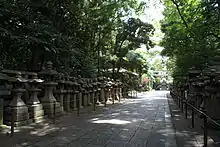Kōshō
Kōshō (康正) was a Japanese era name (年号,, nengō,, lit. "year name") after Kyōtoku and before Chōroku. This period started in July 1455 and ended in September 1457.[1] During this time, the emperor was Go-Hanazono-tennō (後花園天皇).[2]
Events of the Kōshō era

In the 2nd year of Kōshō, the shogun and members of the Imperial court went together to the Iwashimizu Shrine
Related pages
References
- Nussbaum, Louis-Frédéric. (2005). "Kōshō" in Japan encyclopedia, p. 564.
- Nussbaum, "Go-Hanazono Tennō," p. 252; Titsingh, Isaac. (1834). Annales des empereurs du japon, pp. 331-348.
- Titsingh, p. 348.
Other websites
- National Diet Library, "The Japanese Calendar" -- historical overview plus illustrative images from library's collection
| Kōshō | 1st | 2nd | 3rd |
|---|---|---|---|
| 1455 | 1456 | 1457 |
| Preceded by: Kyōtoku |
Era or nengō: Kōshō |
Succeeded by: Chōroku |
This article is issued from Wikipedia. The text is licensed under Creative Commons - Attribution - Sharealike. Additional terms may apply for the media files.